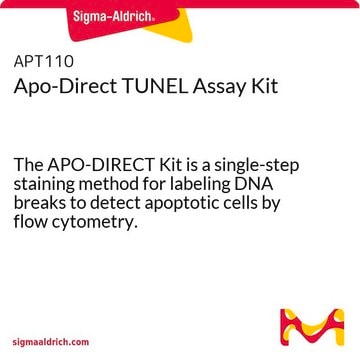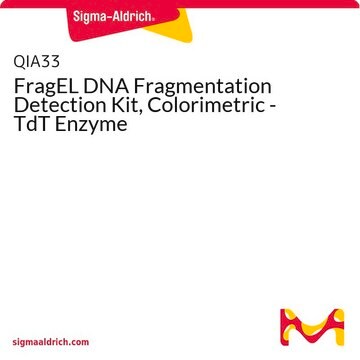11684809910
Roche
In Situ Cell Death Detection Kit, AP
sufficient for ≤50 tests, kit of 1 (3 components), suitable for detection
Sinônimo(s):
cell death kit
About This Item
Produtos recomendados
uso
sufficient for ≤50 tests
Nível de qualidade
embalagem
kit of 1 (3 components)
fabricante/nome comercial
Roche
técnica(s)
immunohistochemistry: suitable
aplicação(ões)
detection
temperatura de armazenamento
−20°C
Categorias relacionadas
Descrição geral
Contents:
- Enzyme Solution (TdT)
- Label Solution (fluorescein-dUTP)
- Converter AP (anti-fluorescein antibody-AP), ready-to-use
Especificidade
Aplicação
- Detection of individual apoptotic cells in frozen and formalin-fixed tissue sections in basic research†
- Determination of sensitivity of malignant cells to drug-induced apoptosis in cancer research
- Typing of cells undergoing cell death in heterogeneous populations by double staining procedures
Características e benefícios
- Sensitive: The maximum intensity of labeling (cell staining) of apoptotic cells is higher than the nick translation method
- Fast: The use of fluorescein-dUTP allows analysis of the samples directly after the TUNEL reaction, but before the addition of the secondary detection system
- Convenient: The direct labeling procedure using fluorescein-dUTP allows verification of the efficiency of the TUNEL reaction during the assay procedure
- Accurate: Identification of apoptosis at a molecular level (DNA-strand breaks) and identification of cells at the very early stages of apoptosis
- Flexible: No substrate included; provides the opportunity to select the staining procedure of choice
Embalagem
Especificações
The hallmark of apoptosis is DNA degradation, which in early stages is selective to the internucleosomal DNA linker regions. The DNA cleavage may yield double-stranded and single-stranded DNA breaks (nicks). Both types of breaks can be detected by labeling the free 3′-OH termini with modified nucleotides (e.g., biotin-dUTP, DIG-dUTP, fluorescein-dUTP) in an enzymatic reaction. The enzyme terminal deoxynucleotidyl transferase (TdT) catalyzes the template-independent polymerization of deoxyribonucleotides to the 3′-end of single- and double-stranded DNA. This method has also been termed TUNEL (TdT-mediated dUTP-X nick end labeling). Alternatively, free 3′-OH groups may be labeled using DNA polymerases by the template-dependent mechanism called nick translation. However, the TUNEL method is considered to be more sensitive and faster.
Sample material: Cytospin and cell smear preparations, adherent cells grown on slides, and frozen and paraffin-embedded tissue sections.
Princípio
Apoptotic cells are fixed and permeabilized. Subsequently, the cells are incubated with the TUNEL reaction mixture that contains TdT and fluorescein-dUTP. During this incubation period, TdT catalyzes the addition of fluorescein-dUTP at free 3′-OH groups in single- and double-stranded DNA. After washing, the label incorporated at the damaged sites of the DNA is marked by an anti-fluorescein antibody conjugated with the reporter enzyme alkaline phosphatase. After washing to remove unbound enzyme conjugate, the AP retained in the immune complex is visualized by a substrate reaction.
Nota de preparo
Mix well to equilibrate components.
Storage conditions (working solution): TUNEL reaction mixture
The TUNEL reaction mixture should be prepared immediately before use and should not be stored. Keep TUNEL reaction mixture on ice until use.
Converter-AP
Once thawed the Converter-AP solution should be stored at 2 to 8 °C (maximum stability
6 months).
Note: Do not freeze.
Outras notas
Somente componentes do kit
- Enzyme Solution (TdT)
- Label Solution (fluorescein-dUTP)
- Converter AP (anti-fluorescein antibody-AP) ready-to-use
Palavra indicadora
Danger
Frases de perigo
Declarações de precaução
Classificações de perigo
Aquatic Chronic 2 - Carc. 1B Inhalation - Skin Sens. 1
Código de classe de armazenamento
6.1D - Non-combustible acute toxic Cat.3 / toxic hazardous materials or hazardous materials causing chronic effects
Classe de risco de água (WGK)
WGK 3
Ponto de fulgor (°F)
does not flash
Ponto de fulgor (°C)
does not flash
Certificados de análise (COA)
Busque Certificados de análise (COA) digitando o Número do Lote do produto. Os números de lote e remessa podem ser encontrados no rótulo de um produto após a palavra “Lot” ou “Batch”.
Já possui este produto?
Encontre a documentação dos produtos que você adquiriu recentemente na biblioteca de documentos.
Os clientes também visualizaram
Artigos
Cellular apoptosis assays to detect programmed cell death using Annexin V, Caspase and TUNEL DNA fragmentation assays.
Nossa equipe de cientistas tem experiência em todas as áreas de pesquisa, incluindo Life Sciences, ciência de materiais, síntese química, cromatografia, química analítica e muitas outras.
Entre em contato com a assistência técnica










